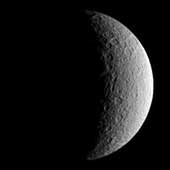|
COMETS EARTH JUPITER KUIPER BELT MARS MERCURY METEORITES NEPTUNE OORT CLOUD PLUTO SATURN SOLAR SYSTEM SPACE SUN URANUS VENUS ORDER PRINTS
PHOTO CATEGORIES SCIENCEVIEWS AMERICAN INDIAN AMPHIBIANS BIRDS BUGS FINE ART FOSSILS THE ISLANDS HISTORICAL PHOTOS MAMMALS OTHER PARKS PLANTS RELIGIOUS REPTILES SCIENCEVIEWS PRINTS
|
Related Documents
Download Options
The first artificial satellite in the Saturn system, the Cassini spacecraft, returned images of the natural moons following a successful insertion into orbit. This is an unmagnified view of the moon Rhea. With a diameter of 1,528 kilometers (950 miles) across, Rhea is Saturn's second largest moon. The Voyager spacecraft found that like Dione, Rhea has one of its hemispheres covered with bright, wispy streaks which may be water frost. This view shows a heavily cratered surface, and thus it is most likely ancient. Many of the craters visible here have central peaks. Cassini soon will look for clues to help unlock the moon's geologic history. The spacecraft is slated to fly by Rhea at a distance of only 500 kilometers (311 miles) on Nov. 26, 2005. The image was taken in visible light with the Cassini spacecraft narrow angle camera on July 2, 2004, from a distance of about 990,000 kilometers (615,000 miles) from Rhea and at a Sun-Rhea-spacecraft, or phase angle of about 109 degrees. The image scale is 6 kilometers (4 miles) per pixel. |
